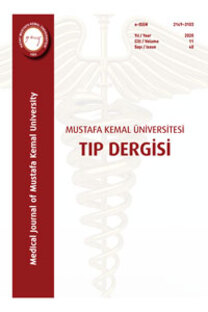ÖZGÜN MAKALE/ORIGINAL ARTICLE
Digoksin, toksisite, intoksikasyon, serum digoksin düzeyleri
DIGOXIN TOXICITY IN THERAPEUTIC SERUM LEVELS
Digoxin, toxicity, intoxication, serum digoxin levels,
___
- Uretsky BF, Young JB, Shahidi FE, Yellen LG, Harrison MC, Jolly MK. Randomized study assessing the effect of digoxin withdrawal in patients with mild to moderate chronic congestive heart failure: results of the PROVED trial. PROVED Investigative Group. J Am CollCardiol 1993; 22: 955-62.
- Packer M, Gheorghiade M, Young JB, Costantini PJ, Adams KF, Cody RJ, et al. Withdrawal of digoxin from patients with chronic heart failure treated with angiotensin-converting-enzyme inhibitors. RADIANCE Study. N Engl J Med 1993; 329: 1-7.
- The effect of digoxin on mortality and morbidity in patients with heart failure. The Digitalis Investigation Group. N Engl J Med 1997; 336: 525-33.
- Ahmed A, Rich MW, Love TE, Lloyd-Jones DM, Aban IB, Colucci WS, et al. Digoxin and reduction in mortality and hospitalization in heart failure: a comprehensive post hoc analysis of the DIG trial. Eur Heart J 2006; 27: 178-86.
- Gheorghiade M, Braunwald E. Reconsidering the role for digoxin in the management of acute heart failure syndromes. Jama 2009; 302: 2146-7.
- Hussain Z, Swindle J, Hauptman PJ. Digoxin use and digoxin toxicity in the post-DIG trial era. J Card Fail 2006; 12: 343-6.
- See I, Shehab N, Kegler SR, Laskar SR, Budnitz DS. Emergency department visits and hospitalizations for digoxin toxicity: United States, 2005 to 2010. Circ Heart Fail 2014; 7: 28-34.
- Miura T, Kojima R, Sugiura Y, Mizutani M, Takatsu F, Suzuki Y. Effect of aging on the incidence of digoxin toxicity. Ann Pharmacother 2000; 34: 427-32
- JS B, MA K. Tintinalli's Emergency Medicine, A Comprehensive Study Guide. In Digitalis Glycosides, ed. T J, pp. 1260-4. New York: McGraw Hill; 2010.
- Kirilmaz B, Saygi S, Gungor H, Onsel Turk U, Alioglu E, Akyuz S, Asgun F, Tengiz I, Ercan E. Digoxin intoxication: An old enemy in modern era. J Geriatr Cardiol 2012; 9: 237-42.
- Borron SW, Bismuth C, Muszynski J. Advances in the management of digoxin toxicity in the older patient. Drugs Aging 1997; 10: 18-33.
- Passmore AP, Johnston GD. Digoxin toxicity in the aged. Characterising and avoiding the problem. Drugs Aging 1991; 1: 364-79.
- Gheorghiade M, Adams KF, Jr., Colucci WS. Digoxin in the management of cardiovascular disorders. Circulation 2004; 109: 2959-64.
- Beller GA, Conroy J, Smith TW. Ischemia-induced alterations in myocardial (Na+ + K+)-ATPase and cardiac glycoside binding. J Clin Invest 1976; 57: 341-50.
- Whitbeck MG, Charnigo RJ, Khairy P, Ziada K, Bailey AL, Zegarra MM, et al. Increased mortality among patients taking digoxin--analysis from the AFFIRM study. Eur Heart J 2013; 34: 1481-8.
- Corley SD, Epstein AE, DiMarco JP, Domanski MJ, Geller N, Greene HL, et al. Relationships between sinus rhythm, treatment, and survival in the Atrial Fibrillation Follow-Up Investigation of Rhythm Management (AFFIRM) Study. Circulation 2004; 109: 1509-13.
- Biteker M, Duman D, Dayan A, Can MM, Tekkesin AI. Inappropriate use of digoxin in elderly patients presenting to an outpatient cardiology clinic of a tertiary hospital in Turkey. Turk Kardiyol Dern Ars 2011; 39: 365-70.
- ISSN: 2149-3103
- Yayın Aralığı: Yılda 3 Sayı
- Başlangıç: 2010
- Yayıncı: Hatay Mustafa Kemal Üniversitesi Tıp Fakültesi Dekanlığı
Ameloblastomanın Konik Işınlı Bilgisayarlı Tomografi ile Değerlendirilmesi
Güray Can, Hatice Can, Bülent Yılmaz, Uğur Korkmaz, Hasan Celalettin Ümit, Emrah Poşul, Gülbin Ünsal, Ahmet Tezel, Ali Soylu, Mevlüt Kurt
Serdar Olt, Mustafa Selçuk, Ayşe Tutak, Fatma Akbaş, Orhan Öznas
Ağırlık Kaldırılması Sonrası Gelişen Desendan Aortic İntramural Hematom; olgu sunumu
Absans Epilepsi Patofizyolojisinde Netrin-1’in Yeri
Ramazan Yüksel, Gönül Gürol, Zeynep Akkılık, Yunus Yükselten, Sibel Sarı, Ahmet Yeni, Sevil Arabacı, Didem Güneri, Fatih Ekici, Kadir Demircan
Psödotümör Serebri Kliniği İle Gelen Spinal Kitle Olgusu
Ümmü AYDOĞMUŞ, Cahide YILMAZ, Ömer BEKTAŞ, Alev GÜVEN, Birce TAŞKIN, Zeynep KARALÖK, Tülin ŞAYLI
Sahte İsmini Haketmeyen Genler; Psödogenler
Dilara Sönmez, Bülent Göğebakan, Hasret Ecevit, Leyla Ataç, Meral Urhan Küçük, Müzeyyen İzmirli
Yabancı Cisim Aspirasyona Bağlı Total Atelektazi Olgusunda Acil Bronkoskopi Uygulamamız
Hayrünisa Kahraman Esen, Osman Esen, Elif Atar Gaygusuz, Mustafa Akay
Mahmut Bulut, Mehmet Kaya, Yasin Bez, Mehmet Güneş, Abdullah Atlı, Süleyman Demir, Aslıhan Okan İbiloğlu, Cem Uysal, Aytekin Sır
D&C operasyonlarında sedoanaljezi için propofol ile kullanılan farklı opioidlerin karşılaştırılması
Sedat Hakimoğlu, Işıl Davarcı, Kasım Tuzcu, Murat Karcıoğlu, İlay Gözükara, Çağla Buket Özbakış Akkurt, Selim Turhanoğlu
